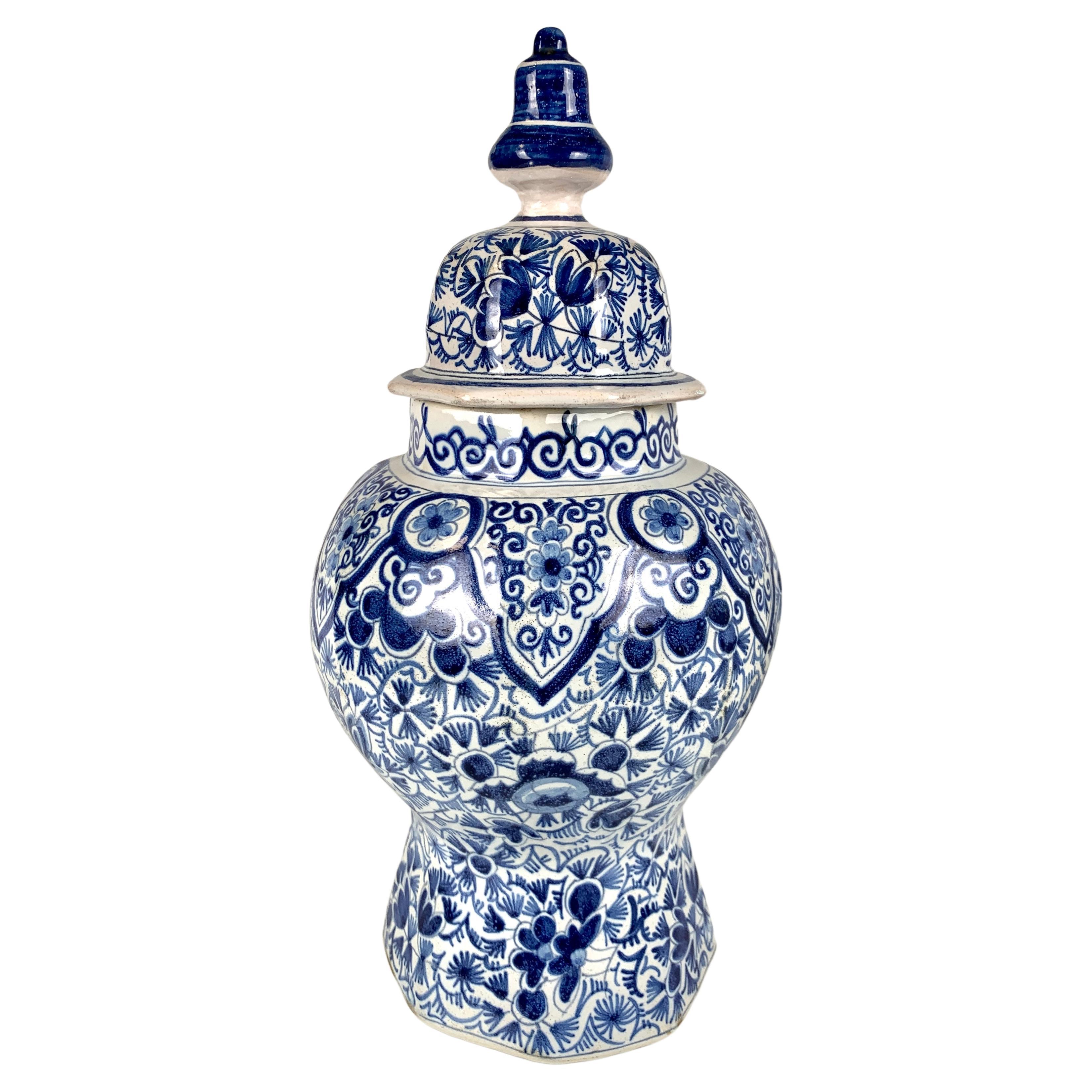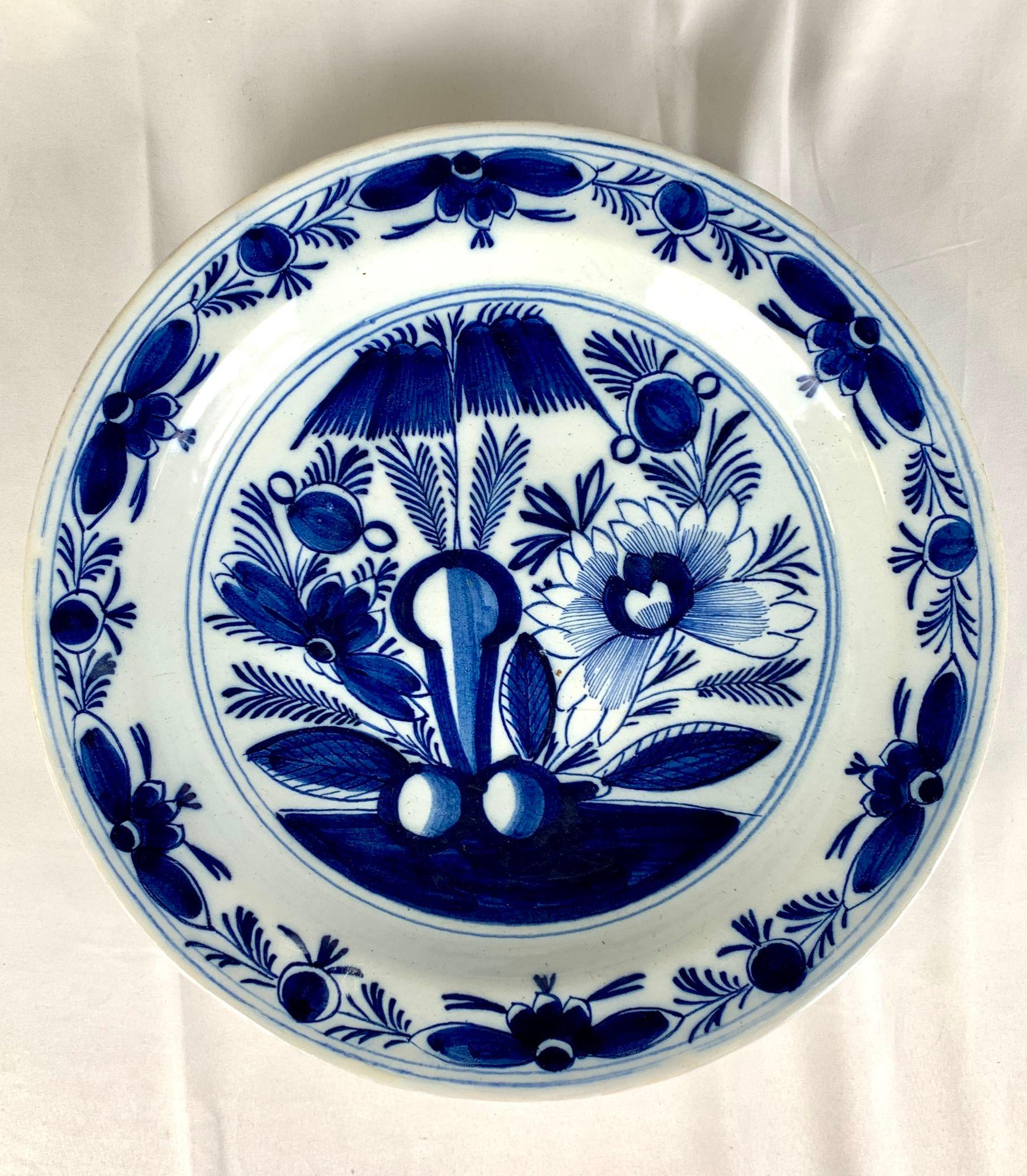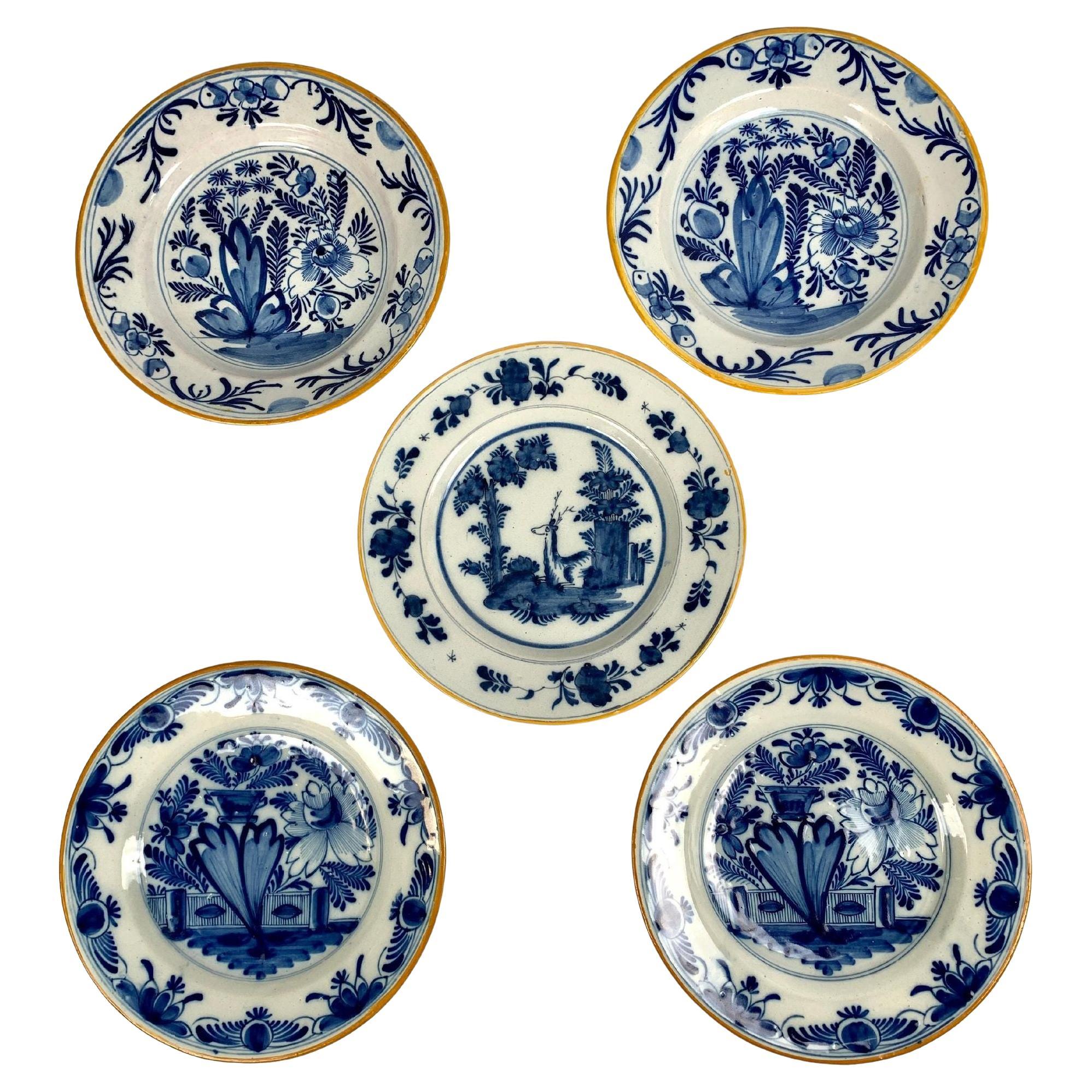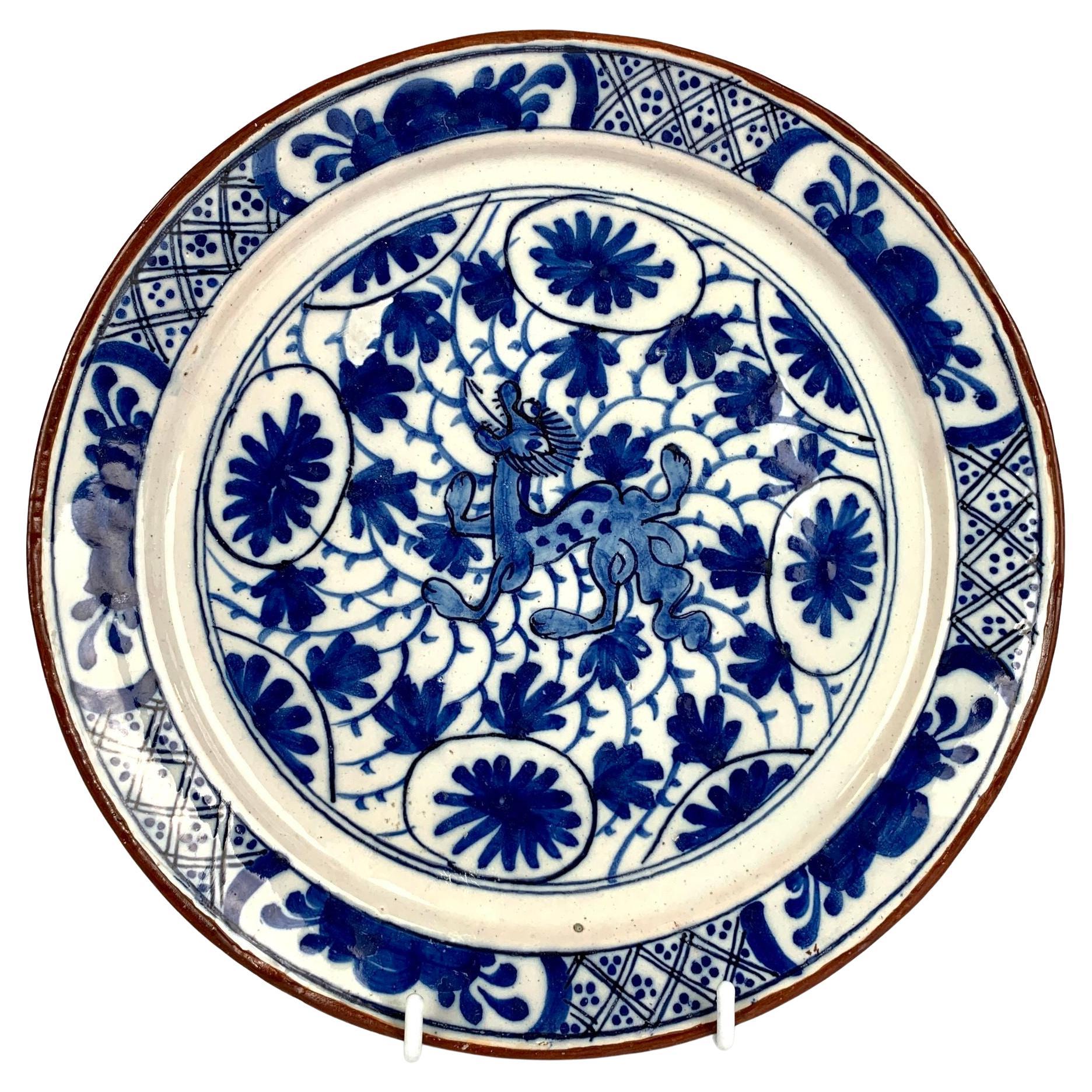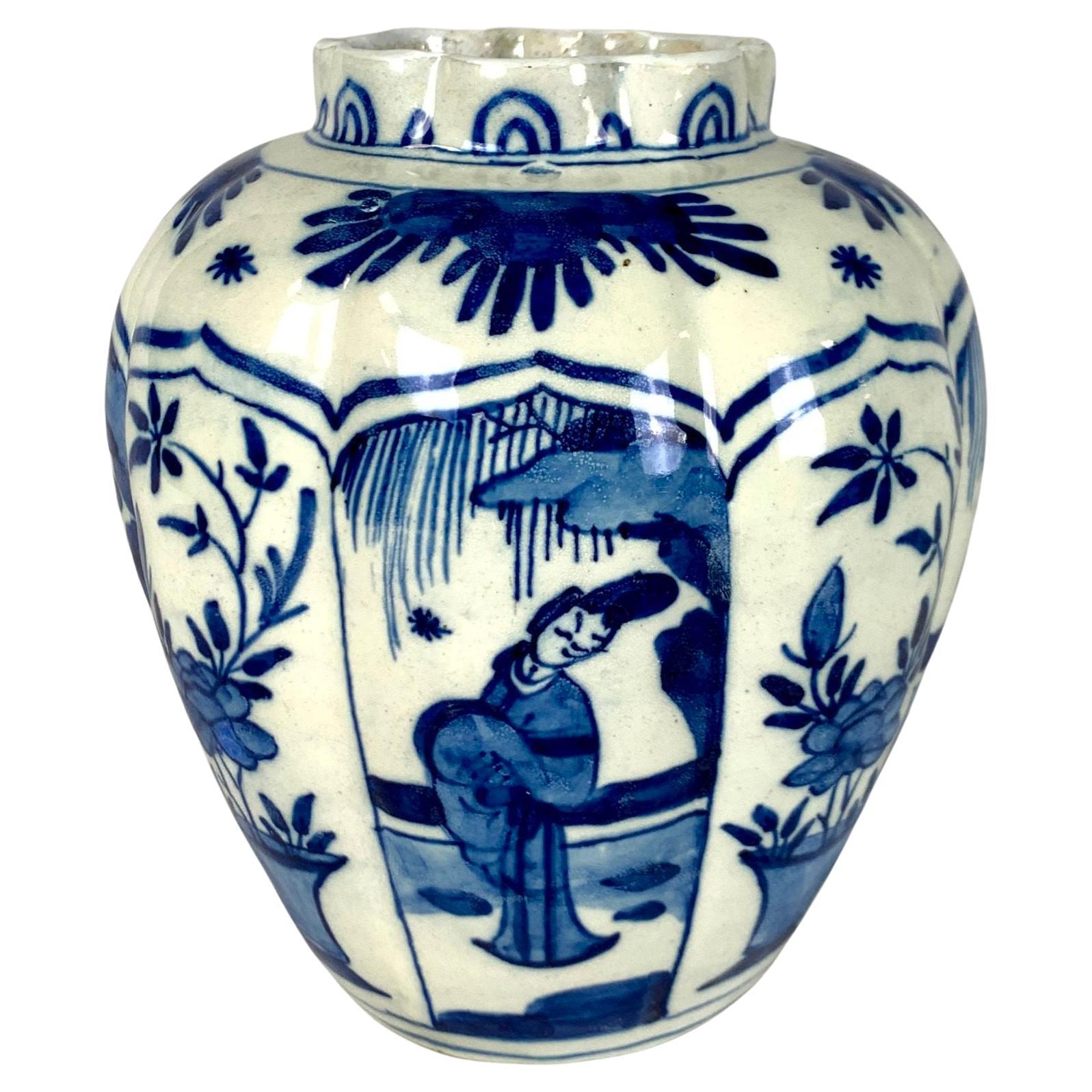Items Similar to Blue and White Delft Plate Hand Painted Netherlands Ca. 1800 w/ Mark of The Claw
Want more images or videos?
Request additional images or videos from the seller
1 of 10
Blue and White Delft Plate Hand Painted Netherlands Ca. 1800 w/ Mark of The Claw
About the Item
This blue and white Delft plate was hand painted circa 1800 in the Netherlands.
Provenance: On the reverse is the mark of De Porceleyene Claeuw, "The Claw" factory operated in Holland from 1658 to 1840.
At the center of this lovely hand-painted dish is a traditional Dutch Delft view of a garden.
The painting has a lovely touch; at the top of the garden view is a teapot!**( for more information on the Dutch history of tea see ** below)
The artist used cobalt blue in various shades to enhance the beauty of the design.
We see an oversized peony, a willow tree, and deep blue rockwork.
The border is adorned with delicate flowers and intricate vines that add an elegant touch to the overall design
The edge is painted with traditional yellow slip.
The dish was made circa 1800.
Dimensions: 8.75" diameter x 1" height
Condition: Excellent.
Price: $470
**The history of tea and teapots in the Netherlands is closely tied to the country's long-standing relationship with trade and exploration.
Tea was introduced to the Netherlands in the early 17th century through the Dutch East India Company (VOC). The VOC played a significant role in global trade and exploration during that time. Dutch traders encountered tea during their voyages to Asia, primarily in China and Japan, and brought it back to the Netherlands.
The Dutch quickly recognized the commercial potential of tea, and the VOC began importing and trading tea from Asia. Initially, tea was a luxury item accessible only to the affluent due to its high cost. However, its popularity gradually grew, and tea consumption spread across various social classes.
Background of Delft: The technique of making Delft was first described in writing by Gerrit Paape in "The Delft Pottery Maker," written in 1794 and dedicated to Lambertus Sanderus, the owner of De Porceleyne Claeuw (The Porcelain Claw). Delft faience began in the 17th century. Much of the most beautiful Delft was produced in the Dutch city of Delft. The Delft potters began to coat their pots thoroughly in a white tin glaze. They then covered the white tin glaze with a clear glaze, giving depth to the fired surface and smoothness to cobalt blues. Over time they created a good resemblance to porcelain. By circa 1650, the technical skills of the potters and painters were much improved, and Delft began its golden age.
- Creator:The Claw (Maker)
- Dimensions:Height: 1 in (2.54 cm)Diameter: 8.75 in (22.23 cm)
- Style:Chinoiserie (Of the Period)
- Materials and Techniques:
- Place of Origin:
- Period:
- Date of Manufacture:circa 1800
- Condition:
- Seller Location:Katonah, NY
- Reference Number:
About the Seller
5.0
Recognized Seller
These prestigious sellers are industry leaders and represent the highest echelon for item quality and design.
Platinum Seller
These expertly vetted sellers are 1stDibs' most experienced sellers and are rated highest by our customers.
Established in 1962
1stDibs seller since 2009
422 sales on 1stDibs
Typical response time: <1 hour
- ShippingRetrieving quote...Ships From: Katonah, NY
- Return PolicyA return for this item may be initiated within 30 days of delivery.
More From This SellerView All
- Antique Delft Blue and White Jar Made by The Claw Netherlands Circa 1790By The ClawLocated in Katonah, NYThis hand-painted jar and cover from circa 1790 boasts beautiful Dutch Delft floral artwork. The intricate design features a stunning array of blooms and vines in deep and medium cobalt blue. The shoulders of the jar are adorned with lappets filled with flower heads, and its octagonal form is topped with a simple, deep blue knop. Dimensions: 12.75" tall x 6" at widest point x 4.75" across base Condition: Excellent with small edge frits invisibly restored Price: $1160 Background of Dutch Delft: The technique of making Delft was first described in writing by Gerrit Paape in "The Delft Pottery Maker," written in 1794 and dedicated to Lambertus Sanderus, the owner of De Porceleyne Claeuw (The Porcelain Claw). Delft faience began in the 17th century. Much of the most beautiful Delft was produced in the Dutch city...Category
Antique Late 18th Century Dutch Rococo Jars
MaterialsDelft
- Hand Painted Blue and White Delft Charger Netherlands Circa 1800Located in Katonah, NYThis blue and white Delft charger was hand painted in the Netherlands circa 1800. The center features a garden scene with beautiful flowering peonies. We see blossoming flowers, buds...Category
Antique Late 18th Century Dutch Rococo Delft and Faience
MaterialsDelft
- Five Blue and White Delft Plates or Dishes Hand Painted, Netherlands, Circa 1800Located in Katonah, NYThese five blue and white Delft plates were hand painted in the Netherlands, circa 1800. The lovely plate in the center shows a deer resting in the forest. The two pairs of plates ...Category
Antique Early 19th Century Dutch Rococo Delft and Faience
MaterialsDelft
- Pair Blue and White Delft Plates or Dishes Hand Painted Netherlands, circa 1800Located in Katonah, NYThis pair of blue and white Delft plates were hand painted circa 1800 in the Netherlands. At the center of this lovely pair of dishes is a traditional Dutch Delft view of a garden i...Category
Antique Early 19th Century Dutch Rococo Delft and Faience
MaterialsDelft
- Blue and White Delft Dish or Plate Hand Painted with Dragon Netherlands C-1780Located in Katonah, NYThis exquisite dish is almost identical to a blue and white Delft dish in the Philadelphia Museum of Art Bequest collection of John W. Pepper. 1935-10-39. The dish is described in de...Category
Antique Late 18th Century Dutch Chinoiserie Delft and Faience
MaterialsDelft
- Blue and White Delft Jar Netherlands Made Circa 1800Located in Katonah, NYThis beautiful jar was hand painted in the Netherlands around 1800. It is decorated with a blue and white chinoiserie pattern that features alternating ogival panels with Oriental fi...Category
Antique Early 19th Century Dutch Chinoiserie Delft and Faience
MaterialsDelft
You May Also Like
- Set of 4 Delft Plates and Dishes Hand-Painted with "Peacock" Pattern 1750-1800By Dutch OriginalsLocated in Verviers, BEA set of two peacock design Delft plates, and two larger Delft dishes. All hand-painted with "peacock" pattern. 2 plates marked "De Porceleyne Claeuw" Dimensions: diameter of 9" / 23cm each plate. 2 dishes are also marked, one for "De Porceleyne Claeuw" (Porcelain Claw) and the other one marked 'De drie...Category
Antique Late 18th Century Dutch Baroque Ceramics
MaterialsCeramic, Delft, Faience
- Delft - 18th century 'Chinoiserie' Blue and White Delft PlateBy DelftLocated in DELFT, NLDutch Delft blue and white plate with a 'Chinoiserie' decoration of a landscape with a fence, flowering peony and willows. Good condition: light chipping and some usual wear to the...Category
Antique Early 18th Century Dutch Chinoiserie Delft and Faience
MaterialsEarthenware, Delft, Faience
- Delft 1750 - 1800 Large Blue and White Tobacco Jar ‘No. 12’ Mark: LpkanBy DelftLocated in ROSSUM, GEBlue and white tobacco jar ‘No. 12’ Delft, 1750-1800 The Lampet Jug pottery Mark: LPKan The ovoid tobacco jar has a protruding rim and...Category
Antique Late 18th Century Dutch Baroque Delft and Faience
MaterialsCeramic, Faience
- Blue and White Chinoiserie Plate, Delft, 1650-1670By DelftLocated in Verviers, BEBlue and white plate with a chinoiserie landscape with two sitting Chinese figures, within a double circle. The back of the plate is painted with the number 5, and the foot rim is pi...Category
Antique Late 17th Century Dutch Chinoiserie Ceramics
MaterialsCeramic, Faience
- Delft Blue and White Chinoiserie Dish the Netherlands, 1675-1700 ChinoiserieBy DelftLocated in ROSSUM, GELarge blue and white chinoiserie dish. The Netherlands, 1675-1700. The blue and white dish has a wide-spreading flange and is painted in the centre with a sitting Chinese figure i...Category
Antique Late 17th Century Dutch Baroque Ceramics
MaterialsCeramic, Majolica
- Delft Jug in Faïence, White and Blue, 19th Century NetherlandsBy DelftLocated in Auribeau sur Siagne, FRThis pot is in Faïence, in white and blue. They has been made in Netherlands, in the 19th century. they are Delft pieces. It is signed underneath.Category
Antique 19th Century Dutch Chinoiserie Delft and Faience
MaterialsFaience
Recently Viewed
View AllMore Ways To Browse
Oversized Teapots
Cobalt Blue Teapot
Chinese Porcelain Blue And White Teapots
Antique Teapot Pottery Porcelain And Glass
Chinese Tea Pots Blue White
Antique Chinese Tea Tin
Antique Chinese Tea Tins
Antique Teapots From India
1840 Silver Teapot
Chinese Tea Tin
Delft Tea Pot
Faience Tea Pot
Delft Teapot
Japanese Tea Tin
Voc Porcelain
Faience Tankard
Gien Dinnerware
Roman Medallions Tin
